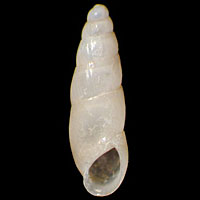|
< Previous family introduction |
|
|||||
 |
Family Epigridae Epigrids
|
|||||
|
Epigridae is a family of small (2-6 mm)
gastropods with tall, fairly robust polished whiteish translucent
shells, found all round Australia. Dead shells are not uncommon,
presumably because of the robustness of their shells, mostly in
sublittoral dredged samples from depths between 5m and 200m, or less
commonly in shell grit on beaches. Live-caught specimens are very scarce
and, as a result, relatively little is known about their way of life.
Epigridae was separated from Rissoidae by Ponder (1985) on the basis of their unusual radula, which is small and relatively broad, with tiny single-cusped central teeth and wide multi-cusped lateral teeth. Four or five species are currently recognised as occurring round Australia. Two names have been applied to forms from NSW; E. cylindraceus (Tenison Woods, 1878) and E. dissimilis (Watson, 1886). These are regarded here as a single species, on the basis that though specimens identified as E. dissimilis are smaller than E cylindraceus, there is no clear size separation and they do not differ significantly in other shell characters. Family references Laseron, C.F., 1950. Review of the Rissoidae of New South Wales, Records of the Australian Museum 22, 257-287 Ponder, W.F., 1985. A review of the genera of the Rissoidae (Mollusca: Mesogastropoda: Rissoacea), Records of the Australian Museum Supplement 4, 1-221 Coverage The single species known from NSW is detailed here. Identification notes Epigridae are small, relatively tall (H/W ca. 3:1) gastropods with relatively solid smooth polished pale translucent or white shells. Distinguishing features include the relatively large (300-400 microns) dome-shaped first whorl, giving the shell a blunt appearance; the lack of any clear distinction between protoconch and teleoconch; the convex spire with 5-7 whorls, which are rounded nearer the apex and rather flat-sided near the aperture; the lack of visible surface sculpture; the rather narrow obliquely drop-shaped aperture, with a narrow interior callus ledge, a sharp return where it meets the spire, a slightly-thickened outer lip without teeth, and a rounded base; when unworn, the shell translucent; the base of the next earlier whorl is visible below the sutures giving the misleading appearance of a broad subsutural groove. This disappears in worn shells, which are whiter and opaque. |